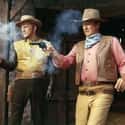-
(#1) You Can Simply Pull Arrows Out Of Your Body
Trope: Arrows are easy to pull out of the body.
Why Is It Inaccurate? Imagine you're a French soldier fighting against the English at the Battle of Agincourt (1415). Suddenly, you're struck by a pointy triangle of metal launched from an English longbow with at least 100 pounds of force.
Fortunately for you, the arrow didn't hit any major organs. Unfortunately, the metal tip has embedded itself in your humerus. Even if you could muster the strength and leverage to rip the arrow out of your arm bone, the pain would make it nearly impossible.
Now, supposing you did, somehow, get that arrow out? Many arrow tips were barbed, so there's a good chance it would take pieces of you with it. You might also just rip out the shaft, leaving the arrow tip (and splinters) behind.
And in the unlikely event you did manage to get the whole thing out? Now you have an infection to worry about.
Notable Offenders: Troy, The Road Warrior, Heroes, Xena: Warrior Princess
-
(#2) Archery Bows Creak When They're Drawn
Trope: Bows make a loud, creaky sound when they're drawn.
Why Is It Inaccurate? Bows aren't the only weapons that get this treatment in Hollywood. You may have noticed that guns and swords also make some stock sounds when they show up on screen, either a "click" or "shing," respectively.
Most archers will tell you: if your bow is creaking, there's something wrong with it. As author and archer J.W. Elliot writes:
BOWS DON'T CREAK! Why would they? When wood is bent it makes no sound until, or unless, it is stressed to the breaking point. Strings don't creak either. They are almost always waxed to keep moisture out and wax simply doesn't creak.
Notable Offenders: Robin Hood, Kingdom of Heaven, Lord of the Rings, Hawkeye
-
(#3) When Sheathing And Unsheathing A Sword, It Makes A Metal-On-Metal 'Sching!'
The Trope: When a knight pulls a sword from its scabbard, the weapon sings out with a "sching" sound.
Why Is It Inaccurate? Swords can make a sound when they slice through the air. But the metal-on-metal noise that sound editors add to shots of warriors unsheathing weapons has little basis in reality.
Swords were carried in scabbards, containers usually made of leather or wood. Thus, it wouldn't be possible for a sword to make a metal-on-metal noise when pulled from a scabbard.
Although some scabbards were made of metal - which theoretically would produce a "sching" sound - medieval ones likely had wool inside to cushion the blade and keep it clean. This would have further muffled any sound the blade made as it was being unsheathed.
Notable Offenders: Frozen; The Lord of the Rings trilogy; Pirates of the Caribbean: The Curse of the Black Pearl; Dracula Untold; Wonder Woman; Merlin
-
(#4) Bullets Ripped Through People Underwater During World War II
The Trope: A soldier attempting to storm a beach, probably somewhere near Normandy, has second thoughts when he's met with a barrage of bullets and dives back under the surf for protection - only to have bullets rip through the water and puncture his body anyway.
Why Is It Inaccurate? Consider that, as recently as 2019, US Special Forces were still hard at working trying to invent a bullet that would travel effectively underwater. Water is, after all, 800 times denser than air, which is what most bullets are designed to pass through. In reality, and as The Smithsonian Channel and the Mythbusters have both conclusively proven, bullets can only pass through a few feet of water at the absolute most, continuously slowing down as they go. As it turns out, real soldiers on D-Day could, and did, earn a temporary reprieve from oncoming gunfire by ducking under the waves.
Notable Offenders: No film is more guilty of this than Saving Private Ryan, where director Steven Spielberg described the difficulty he had replicating bullets passing through water on film without realizing the obvious reason why that was:
Often the pellets wouldn’t go far enough but at least they gave us a really good reference so we were able to digitally augment the shot with a stronger visual of a projectile coursing through the water.
-
(#5) Ammunition Never Runs Out In War
The Trope: Film characters can go an entire two-and-a-half hour movie without ever needing to reload their weapons, despite firing large and indiscriminate bursts of ammunition with alarming frequency.
Why Is It Inaccurate? Supply chains are an ever-underrated and pivotal aspect of warfare, and the limitations thereof have always ensured that real-life soldiers are a lot more conservative with their ammo than their Hollywood counterparts. This is especially true when it comes to World War II, with infantry usually able to carry 100 or so rounds at most into battle, and often far fewer.
It’s also especially true when it came to WWII-era aircraft. The notion of one pilot shooting down multiple enemy bogies on a single run is essentially fiction, with Spitfires specifically carrying 14 seconds' worth of ammo on them at a time. Apparently, nobody told Tom Hardy.
Notable Offenders: Dunkirk, Saving Private Ryan, Where Eagles Dare. In fact, it’d be far easier to list the few programs that make of point of showing their characters reloading and conserving ammo, like Band of Brothers.
-
(#6) World War II Was Fought By Men In Their 30s And 40s
The Trope: The typical WWII combatant was a tough and grizzled 30- or 40-something, best portrayed by Hollywood’s leading middle-aged actors like the Toms Hanks and Tom Hardy.
Why Is It Inaccurate? The average WWII soldier was much younger than the average age of the actors who portray them. Or, as The Saturday Evening Post puts it:
[I]f you were the average frontline G.I., you would fit the following description. You are a 26-years-old white male with nine years of education, who comes from New York and is named John. You were drafted into the army and are now a rifleman in the infantry with a rank of private.
Back home, you have a wife and at least one child hoping for your return. You are 5 feet, 8 inches tall, and you weigh 144 pounds. During your basic training, which you received at Fort Benning, GA, you gained 5 to 20 pounds and added an inch to your 33 1/4-inch chest.That may not sound like the stuff of a blockbuster action flick, but it is reality. And while older actors may add gravitas to a role, so too does the knowledge that the majority of those who fought and perished in the war still had their whole lives ahead of them.
Even combat officers tended to be young; for instance, Easy Company's commander Major Dick Winters was all of 27 when the war ended. By contrast, Tom Hanks was 41 when he portrayed the fictional Captain John Miller in Saving Private Ryan (although, according to this fan wiki, the character is supposed to be "only" 34). Meanwhile, Tom Sizemore, who played Tech Sgt. Mike Horvath, was 35 when the movie was filmed.
Notable Offenders: Saving Private Ryan, The Longest Day, Battle of the Bulge
-
(#7) The Best Old West Gunslingers Always Shoot From The Hip During A Fight
The Trope: In a quick-draw gunfight, gunslingers rapidly remove their pistol from their holster and accurately shoot from their hip.
Why Is It Inaccurate? To hit a target, gunslingers - a word from the 1920s used to describe gunfighters - would need to aim their weapon accurately, something that would have been nearly impossible to do from the hip. As Old West Texas Ranger Captain James B. Gillett recalled:
In all my experience with both officers and desperadoes... I never saw a man shoot from the hip. All of them pulled the pistol, pointed it from the shoulder level and fired.
Hip shots were so ill-advised and risky that most gunslingers never used the skill during fights. Wild Bill Hickok was apparently one of the few who did. As one admirer remembered:
Wild Bill saved himself in a good many fights by his peculiar way of shooting. He either shot direct from his hip, without waiting to raise his gun, or else - as was most common with him - on the up-go; that is, he shot as he was raising his pistols up. This fraction of a second advantage over the men who shot on the drop of down-go of their guns, saved his life at least a dozen times.
But even this account is revealing: Wild Bill's skill was "peculiar," and thus not widely practiced. Instead, skills like his would have been features of exhibitions and Wild West shows.
Indeed, gun tricks like shooting from the hip had little use in a real-world fight. When the stakes were life and death, not many gunslingers would have gambled with a hip shot to bring their opponent down.
Notable Offenders: Shane; The Good, the Bad, and the Ugly; Red Dead Redemption 2
-
(#8) Pirates Made A Living By Raiding Coastal Towns
The Trope: Pirates appear outside a town sitting on the coast. Soon they swarm over the sides of their ships, pouring into the streets to kidnap women and steal goods. Then they sail away to sea - until their next attack.
Why Is It Inaccurate? Pirates were frequent visitors to coastal towns, but often because they had wives in town. Turns out most coastal towns welcomed pirates who visited between sailings. On top of that, pirates specialized in raiding ships, not towns. Ships carried the spices, gold, and riches that pirates seized.
Take, for example, Captain Thomas Tew, who seized several ships without a fight and captured a huge amount of wealth. Or Captain Henry Every, who seized a single ship in the Red Sea and captured the equivalent of tens of millions of dollars' worth of goods in two hours without losing a single man. Why raid coastal towns when poorly defended ships were much easier prey?
Notable Offenders: In Pirates of the Caribbean: The Curse of the Black Pearl, Jack Sparrow makes plans to "raid, pillage, and plunder" his guts out.
-
(#9) Renaissance Women Wore Their Hair Long And Down
The Trope: Renaissance women let their hair flow free, growing it extremely long.
Why Is It Inaccurate? Although women did have long hair in the Renaissance, they typically swept it up and hid it under hairnets or veils. Long, flowing hair often interfered with fashion, like the collars and neck ruffs that became popular in 16th century England.
Notable Offenders: The Borgias, The Tudors, The Other Boleyn Girl
-
(#10) Renaissance Men Wore Their Doublets Open
The Trope: Renaissance men liked to show a fair amount of chest hair while walking down the street.
Why Is It Inaccurate? That white shirt under the doublet is called a chemise, and wasn't meant to be seen at all - it was the Renaissance equivalent of underwear. So when Joseph Fiennes wanders the streets of London with his doublet wide open, he's showing off his underwear for everyone to see.
Actors sometimes sport a similarly inaccurate style when they appear without a chemise at all. But the garment served a critical function during the Renaissance. In an era when people washed their clothes less frequently, the chemise kept sweat and grime off people's fancy clothes.
Notable Offenders: Shakespeare in Love
-
(#11) Cleopatra Was An Otherworldly Beauty
The Trope: Cleopatra is one of the most stunning and physically captivating women to have ever existed. She uses these preternatural good looks to her political advantage.
Why Is It Inaccurate? "The more we study Cleopatra's surviving images, the less certain we may be of her looks,'' says British Museum curator Susan Walker. In the few coins that depict her, Cleopatra possesses a pronounced hooked nose and pointed chin - bearing little resemblance to later characterizations. Walker seems to agree with the ancient Greek historian and philosopher Plutarch, who wrote that "Cleopatra's greatest allure lay in the sound of her voice and the charm of her company."
Notable Offenders: Every painting and film featuring Cleopatra, the latter of which star beauties like Elizabeth Taylor, Theda Bara, Vivien Leigh, and Claudette Colbert.
-
(#12) Eating Turkey Legs Was Common During The Renaissance
The Trope: At Renaissance banquets, diners gnawed on enormous turkey legs.
Why Is It Inaccurate? There's a big problem with the turkey leg trope: Turkeys are native to the New World and didn't appear in Europe until the mid-16th century - nearly the end of the Renaissance.
Before turkeys showed up at banquets, Renaissance diners enjoyed beef, soups, and peacocks. In fact, peacock leg might be more accurate than turkey leg for most of the period.
As for turkey legs, they didn't look the same in the 16th century. Back then, turkeys were wild game - much smaller than today's birds. The enormous turkey legs we picture today actually became popular at Renaissance Faires.
Notable Offenders: Blame this one on the Renaissance Faire and the 1933 film The Private Life of Henry VIII, although it's possible he's supposed to be eating chicken.
-
(#13) Cleopatra
- Notable Figure
The Trope: Cleopatra was ethnically Egyptian.
Why Is It Inaccurate? Cleopatra and her ancestors, despite ruling over Egypt, were ethnically Greek. The Ptolemaic dynasty originated with Ptolemy I, a Macedonian Greek general who inherited the empire after Alexander the Great's passing.
Cleopatra donned Egyptian attire and took the time to learn the language. She also adopted the customs and religious practices of Egyptian natives. Ptolemaic rulers like herself were even crowned as pharaohs. That being said, Cleopatra was a Macedonian royal through and through whose native language was Koine Greek.
Notable Offenders: The 1945 film Caesar and Cleopatra, starring Vivien Leigh and Claude Rains, amplifies Cleopatra's "exotic" nature in very problematic and false ways, creating a stark contrast between the Egyptian ruler and her Roman adviser-turned-lover Julius Caesar.
-
(#14) Victorians Had No Sense Of Humor
The Trope: All Victorians maintained a depressive and dreary attitude about life, one completely devoid of humor.
Why It's Wrong: How could the era that introduced the world to Sherlock Holmes lack any comedic qualities? Sharing jokes was an honored pastime in Victorian England, where the term "laugh and grow fat" was taken very seriously. Professional humorists made their living writing jokes all day, and personal ads were dominated by singles in need of a partner who could make them laugh.
Notable Offenders: Popular Victorian novelists like Charles Dickens and Thomas Hardy reveled in working-class woe, and this tone carried over into many of the BBC adaptations of famous Victorian written works.
-
(#15) You Don't Need To Pull Your String Back All The Way
Trope: Archers don't need to pull their bowstrings back all the way.
Why Is It Inaccurate? Unlike a pistol, which only needs to be loaded and cocked to be effective, a bow is only as powerful as its archer.
If you want a solid shot, you need to have good form, and that means pulling back your bowstring all the way, until it's taut. This is called a "full draw." A half pull will result in your arrow dropping to the ground immediately. Not effective!
Notable Offenders: The Hunger Games, Charlie's Angels
-
(#16) Victorians Were Prudes
The Trope: Sex was only a procreative act.
Why It's Wrong: Sexual education definitely wasn't a thing in the Victorian world, and women were held to much different standards than men. That being said, not all Victorians were sexually repressed. Adult content was easy to find, as were escorts. While the public-facing message was one of chastity, Victorians were engaged in all kinds of lascivious activities behind closed doors.
Notable Offenders: Published guides to sex and sexuality were popular in the 19th century, but these books favored men much more than women. Books like 1899's What a Young Husband Ought to Know and 1894's Sex Tips for Husbands and Wives uphold these unfair standards that downplay physical desire. "Give little, give seldom and above all give grudgingly. Otherwise what could have been a proper marriage could become an orgy of sexual lust," author Ruth Smythers writes to young wives at the end of the latter book.
New Random Displays Display All By Ranking
About This Tool
Our data comes from Ranker, If you want to participate in the ranking of items displayed on this page, please click here.
















